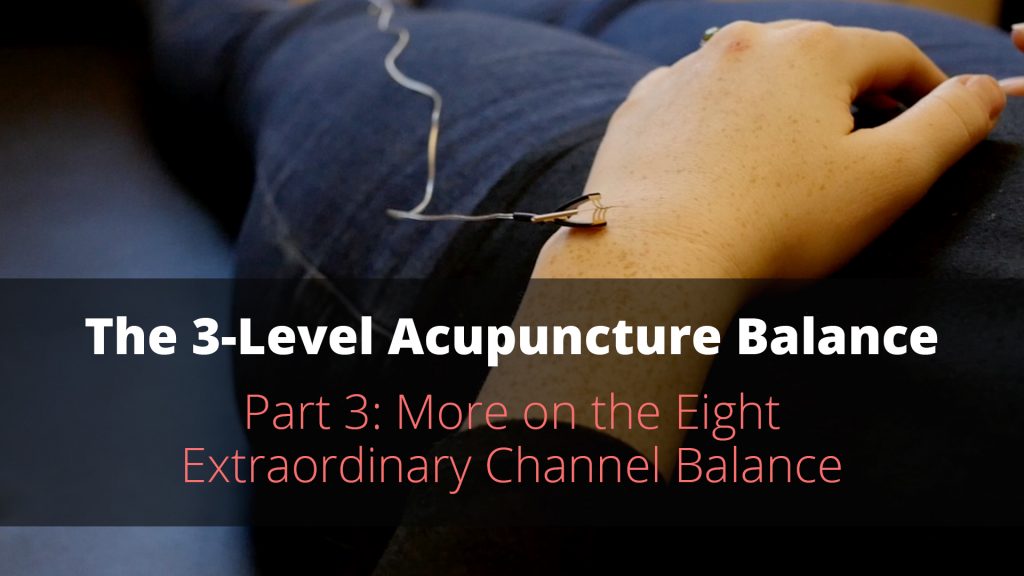
This is the 3rd post in my 3-Level Acupuncture Balance blog series. If you have not read the first two posts, you may want to read them before you continue.
You can get caught up, or refresh your memory, here:
Click here to read part 1, Part 1- The Treatment >>
Click here to read part 2, Part 2- Historical Development >>
—————————————————————————
The 3-Level Acupuncture Protocol balances the Primary Channels (to regulate circulation of qi and blood), the Eight Extraordinary Channels (to regulate the musculoskeletal body), and the Divergent Channels (to regulate the internal zang-fu organs).
In this article, I will go into more detail regarding the Eight Extraordinary Channels, pointing out the differences between the Chinese and Japanese approach, both theoretically and clinically.
I will often shorten Eight Extraordinary Channels to “8 Extras”.
Chinese Understanding of the 8 Extraordinary Channels
In the traditional Chinese approach, the 8 Extra channels are considered to be storage vessels or reservoirs of energy. They store and distribute yuan-jing, our original constitutional energy. They are considered “pre-heaven channels”, and are important in fetal development.
The 8 Extras are not regular channels like the primary channels; they follow their own course circulation without connections to cutaneous, sinew, or channel divergences. They do not have normal yang-yin pairs, are not associated directly with the zang-fu, and do not have dedicated acupuncture points. However, they cross primary channel points and are controlled, influenced, and treated by primary channel points.
In the Chinese approach, The 8 Extras are seen as constitutional vessels, representing the link between pre-heaven (inherited) energies, and post-heaven (acquired) energies.
Energy circulation in the Eight Extra channels help to maintain the inner equilibrium of qi, blood and distribution of jing. Part of their importance is to handle overflow and excess of qi and blood from primary channel system. In the Nanjing, the 8 Extra were described as reservoirs in case of primary channel depletion, and as reservoirs in case of primary channel excess. In this regard, they can absorb and transfer excess during blockages in the primary channel network. This happens where 8 Extra channels cross the Primary channels.
Some sources believe that the 8 Extra cross the Primary channel points at the yuan-source points, allowing access to reservoirs of yuan qi from the 8 Extra network.
Although the 8 Extras were discussed in the medical classics, they did not come into clinical use until the 14th century, when it was seen that 8 Extras could be influenced by treating points of the Primary channels.
Specific Functions of the 8 Extra in Classical Chinese Medicine
- Enables the various stages of growth and life
- Fertility and conception
- Embryological development
- Prenatal energy in the 8 Extras consist of the parents’ jing, the embryo’s yuan-source qi, and zong qi (the cosmic or ancestral qi)
- 8 Extras link pre-heaven and post-heaven qi
- Manage, circulate and distribute jing
- Jing is transformed into qi
- Distribute ying qi, wei qi, fluids and blood
- Distributes qi to the zang-fu via Triple Energizer function
- Nourishes marrow and brain
Functions of the Individual 8 Extra Channels in TCM
Ren Mai
- Controls all aspects, functions and location of yin
- Command/confluent point: LU 7
Du Mai
- Controls all aspects, functions and location of yang
- Command/confluent point: SI 3
Chong Mai
- Original Chinese name meant “pregnancy”
- Important for uterus, ovary, fertility, menses
- Command/confluent point: SP 4
Dai Mai
- Belt/Girdle vessel
- Command/confluent point: GB 41
Yang Wei Mai
- Yang Linking: links all yang channels
- Command/confluent point: TE 5
Yin Wei Mai
- Yin Linking: links all yin channels
- Command/confluent point: PC 6
Yang Qiao Mai
- Yang Motility
- Qiao means “to lift up one’s heel”
- Command/confluent point: BL 62
Yin Qiao Mai
- Yin Motility
- Command/confluent point: KI 6
—————————————————————————
Traditional Pairings
Lu 7 – KI 6 Ren – Yinqiao
PC 6 – SP 4 Yinwei – Chong
SI 3 – BL 62 Du – Yangqiao
TE 5 – GB 41 Yangwei – Dai
—————————————————————————
Connections with the Primary Channels
Besides the command points, each of the eight channels connect to primary channels. In both the Chinese and Japanese approaches, these connections are often used to reinforce or develop an Eight Extra treatment, combined with a traditional Command point.
Du (GV), SI 3: GV 1 to 28
Ren (CV), LU 7: CV 1 to 24
Chong, SP 4: CV 1, 7; ST 30; KI 11 to 27
Yangwei, TE 5: BL 63; GB 35, 29; SI 10; LI 14; TE 13, 15; GB 13 to 21
Yinwei, PC 6: KI 9; SP 13, 15, 16; LV 14; CV 22, 23
Yangqiao, BL 62: BL 61, 59; GB 29; SI 10; LI 15, 16; GB 20; ST 1 to 4; BL 1
Yinqiao, KI 6: KI 2, 8; ST 12; BL 1
Dai, GB 41: LV 13; GB 26, 27, 28; CV 8; KI 16; BL 52, 23; GV 4
Four of the Extraordinary channels have their own xi-cleft point, for relieving excess. These are:
Yangwei: GB 35
Yinwei: KI 9
Yangqiao: BL 59
Yinqiao: KI 8
Modern Approaches to the Eight Extraordinary Channels
David Twicken, a contemporary scholar on secondary channels, has devoted considerable thought in his book, Eight Extraordinary Channels (2013, Singing Dragon). First, he proposes a layering system for channel systems from superficial to deep.
- Wei Level (most superficial)
- Sinew channels
- Connecting (luo) channels
- Primary channels
- Divergent channels
- Eight Extraordinary channels
- Yuan level – (most deep)
Twicken’s system runs counter to the modern Japanese approach used in the 3-Level Acupuncture Protocol, where the Divergent Channel networks runs deeper than the Eight Extraordinary Channel network, but his sequence is faithful to the classical Chinese understanding.
Dr. Twicken proposes using 8 Extra therapy for problems affecting the yuan and jing, for example, for chronic constitutional weaknesses leading to asthma or lung weakness, use LU 7 – KI 6.

Hamid Montakab, MD, in his book Acupuncture Point and Channel Energetics (Kiener, 2014), displays 8 Extra circulation by seeing the body as a sphere. Du Mai circulates up the back, Ren Mai circulates energy down the front. Yinwei goes up the inside of the sphere; Yangwei goes down the inside of the sphere. Yinqiao goes up the outside of the sphere, and Yangqiao goes down the outside of the sphere. Chong mai goes up and down the center, and the Dai Mai links around the sphere. I incorporate this into an 8 Extra qi gong, which I will talk about in a future post.
Japanese Understanding of the 8 Extraordinary Channels
The 3-Level Balance is a continuation of the work of Yoshio Manaka, MD, his Topological Society, and later, Miki Shima. I give an overview of this history in my last post.
Click here to read my last post: The 3-Level Acupuncture Balance: Part 2- Historical Development >>
Before I move on, I will write more about Manaka’s understanding of the Eight Extraordinary Channels.
Yoshio Manaka developed an 8 Extra channel approach as a stand-alone therapy. He started by discussing the embryological role of the 8 Extra channels, allowing energy to move and develop in the fetus.
Classical Chinese texts allow that the Eight Extraordinary Channels act as pathways by which qi and blood distribute in the embryo, but Manaka went further by saying that the 8 Channels were the only network in the embryo, acting as an origin for a Primary Channel system. This Primary Channel circulation emerges after birth, reaching full maturity by age 3.
Manaka never discussed the 8 Extras as storing and circulating yuan-jing energy, as the Chinese did. There is no indication that he even agreed with this. He did say that the 8 Extras offer a background “ocean of yang” and “ocean of yin” that can replenish the primary channels. Unlike primary channels, the 8 Extra network does not comprise a continuous circuit. They do not distribute energies (qi, blood, ying and wei) like the primary channels.
Starting in the embryo, the 8 Extras regulate the body at the primitive level of symmetric versus asymmetric. As such, they have a much broader regulatory effect on the movement of qi (“primitive signals”) than primary channels. Primary channels, by comparison, serve as specific information pathways (“signal communication”). After birth, the primary channels develop and communicate with one another, providing qi and blood throughout the body, and supplying the needs of the internal zang-fu organs. The 8 Extra network still exists, but now its primary importance is maintaining a balance of the physical structural body.
Manaka proposed a symmetrical model where all aspects of the physical structure are seen divided into yin and yang.
“It is easier and more useful to consider the Eight Extraordinary vessels as dividing lines capable of affecting structural changes as related to the octahedral topological model”.
His octahedral topological model became the foundation for treating the structural body. This paradigm consists of the following:
—————————————————————————
Yin Aspect Yang Aspect
Front Back
Upper Lower
Right side Left side
Inside Outside
—————————————————————————
For maintaining health, Manaka pointed out the importance of keeping the polarities in balance in a four-quadrant structure, as a fundamental way to promote and maintain health.
In a simple understanding of his octahedron model, he proposed the following:
- Ren and Du divide the body left and right
- Chong divides the body into yin and yang
- Dai divides the body top and bottom
- [Wei and Qiao coordinate life changes and are responsible for the aging process]
In the actual octahedron model, Manaka integrates three 8 extra channels with four primary channels:
- Ren mai Divides anterior right and left
- Du mai Divides posterior right and left
- Dai mai Divides superior-inferior
- TW Divides upper, anterior-posterior yang
- GB Divides lower, anterior-posterior yang
- PC Divides upper, anterior-posterior yin
- SP Divides lower, anterior-posterior yin

Manaka determined that the 8 Extra network was a simpler and more fundamental network, developing at the earliest embryologic stages. Accordingly, the manipulation of the four-quadrant body would have much deeper clinical affects then traditional Primary channel treatment.
This manipulation was best accomplished through the 8 Extra pairings, using ion-pumping cords.
To learn more about ion pumping cords and how to use them, read my first post, The 3-Level Acupuncture Balance: Part 1-The Treatment >>
The 8 Extra network, Manaka discovered, could be influenced by all twelve of the primary acupuncture channels. Using his torso palpatory confirmation, he saw the octahedral body influenced, not only by the eight traditional command points, but also by “new” command points assigned to the four channels not included with the original 4 pairs.
Original command points: SI 3, BL 62, TE 5, GB 41, PC 6, SP 4, LU 7, KI 6.
New command points: LV 4, HT 5, LI 5, ST 40
He proposed a chart using all 12 of these command points as influencing the octahedral, divided into upper and lower, and yin and yang.

Miki Shima, in developing Manaka’s material into the Somato-Auricular Therapy (SAT), developed Manaka’s idea to clinically incorporate all 12 channels in an 8 Extra network therapy. Shima coupled these so that they would fit into a traditional Six Division organization:
—————————————————————————
Original Pairs
KI 6 – LU 7
SP 4 – PC 6
BL 62 – SI 3 Taiyang
GB 41 – TE 5 Shaoyang
—————————————————————————
Additional Pairs
ST 40 – LI 5 Yangming
SP 4 – LU 7 Taiyin
KI 6 – HT 5 Shaoyin
LV 4 – PC 6 Jueyin
—————————————————————————
These new “8 Extra” combinations are used in the AcuGraph Divergence menu.
These combinations not only balance the 8 Extra network, but potentially includes all 12 channels via the Six Divisions. Manaka laid the theoretical foundation for this exciting addition to deep channel balancing by proposing these new command points.
Manaka and Miki Shima both felt that manipulating the 8 Extra network first would set the 4-quadrant octahedron into balance, without driving pathogenic energies deeper into the Primary network.
Following 8 Extra treatment with Divergent treatment, as in the 3-Level Balance, allows balance at the level of the primal 8 Extra network, affecting the musculoskeletal body, and then using the Divergent network to create balance between the yin-yang pairs attending to the internal zang-fu organs.
More about Yoshio Manaka and his Contributions
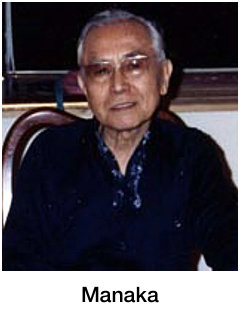 Yoshio Manaka wrote continuously on his ideas and experiments to validate them. Kazuko Itaya and Stephen Birch diligently went through Manaka’s articles with the Topological Society, condensing and organizing this material into the book, Chasing the Dragon’s Tail by Yoshio Manaka (Paradigm Publications, 1995, 2008, 2014.)
Yoshio Manaka wrote continuously on his ideas and experiments to validate them. Kazuko Itaya and Stephen Birch diligently went through Manaka’s articles with the Topological Society, condensing and organizing this material into the book, Chasing the Dragon’s Tail by Yoshio Manaka (Paradigm Publications, 1995, 2008, 2014.)
Manaka was a medical doctor with a Ph.D. in biology. Throughout his professional life, he devoted himself to acupuncture, moxibustion and herbal medicine. He performed numerous scientific experiments testing and expanding the frontiers of acupuncture.
During WWII, Manaka was a Japanese army physician based in the Philippines. While working with burn victims, Manaka placed aluminum foil over burns, and created ion-pumping cords (IPC) to move heat excess to other parts of the body. IPC have a unidirectional flow of electrons, and the successful clinical application in burns started Manaka on his road to discovery and invention.
After the war, Manaka devoted himself to studying the ability of IPC to move places of excess to places of deficiency. This brought him to the field of acupuncture.
To learn more about ion pumping cords and how to use them, read my first post, The 3-Level Acupuncture Balance: Part 1-The Treatment >>
Manaka became a student of Akabane, and began examining the relationship of acupuncture channels to each other. In order to confirm the actual effects of his experiments, Manaka studied, and refined, traditional Japanese palpation diagnosis on the torso.
Using traditional front-mu points for the various zang-fu organs, he would look for signs of tension, flaccidity, moisture, temperature and soreness, comparing torso manifestations before and after applying some sort of intervention. These included needles, magnets, ion pumping cords, etc.
A group of students gathered around Manaka’s teachings (known as the Topological Society) and would confirm Manaka’s findings by reproducing them. Basically, abdominal patterns of tension would change immediately with correct treatment, and the fact that various practitioners could reproduce these effects, lent evidential proof to their discoveries.
Some of the Topological Society’s research included the following:
Meridians
- Confirmed that there is a unidirectional aspect of meridian flow
- That meridian qi follows the primary circuit sequence (eg, LU to LI, LI to ST, ST to SP, etc)
- That qi concentrates in each meridian, in sequence, every two hours
- That there is also a complete cycle through all meridians every 45 minutes, or 50 times per day
Acupuncture Points
- Confirmed classical indications of 5 Element points, as well as tonification, sedation, xi-cleft and luo-connecting points
- Confirmed that the traditional Five Element points could influence tonification and sedation of the channel
- Confirmed that the Five Element points can directly influence relationships with other channels, in agreement with classical teachings
- Confirmed 8 Extraordinary confluent/control points and master-coupled points
- There exists a polarity between tonification and sedation points on the same channel (Manaka would often combine both tonification point with sedation point using IPC)
Ion Pumping Cords (IPC)
- Ion pumping cords allow electricity to flow in one direction only, from black to red
- IPC transference is completed in about 10 minutes
- Besides connecting different channels, IPC can be performed on a single channel. Eg, to reduce excess in the LI channel one can move energy from LI 2 (sedation point) to LI 11 (tonification point)
Manaka also discovered that various agents produce electrical effects that can alter the body’s structure via traditional acupuncture points and the body’s electrical and magnetic fields. Basically, they can can promote tonification or sedation.
—————————————————————————
Agent Tonifies Sedates
Magnet north south
Metals copper zinc
———- gold silver
Finger digits thumb little finger
—————————————————————————
Manaka’s Mu Points
Manaka and his group eventually found that when a patient lies on their back, the best diagnostic points on the torso are different from traditional Front-mu points, and different even from other Japanese hara locations. Manaka would palpate these points to use diagnostically. (I have found that they can also be used by practitioners using muscle-testing.) His new points are as follows:

LU LU 1 to LU 2
LI ST 27 (+ slightly lateral)
ST CV 12 to ST 21
SP SP 21 to GB 26
HT CV 14; CV 17; KI 23
SI ST 26 (+ slightly medial)
BL KI 11
KI KI 16
PC CV 17 + PC 1
TE ST 25 (+ slightly lateral)
GB GB 24 +/to GB 29 (ASIS)
LV LV 14 TO GB 26 (esp. right subcostal)
Manaka’s torso palpation for 8 Extra channel diagnosis are the following:
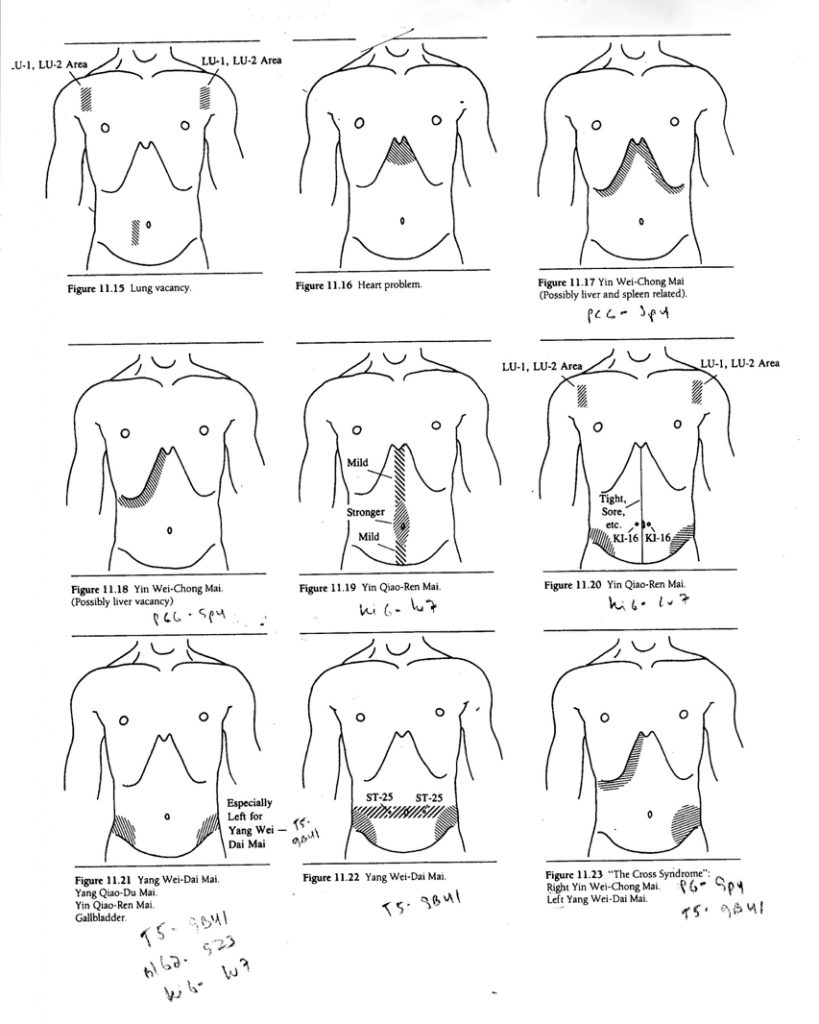

Manaka would often just treat one or two pairs of 8 Extra imbalances, based on torso palpation. He would use IPC for the master-coupled command points, but he would support the treatments with other points.
Here is a list of the supportive points he would use:
—————————————————————————
a. LU 7 (+) – KI 6 (-) Ren – Yinqiao / bilateral
- Ren mai: CV 16 to CV 2
- Upper: LU 1, LU 2, ST 12
- Lower: KI 16, KI 11, ASIS
- Distal: KI 8
b. SP 4 (+) – PC 6 (-) Chong – Yinwei / right side or bilateral
- Dx: Subcostal region, esp right
- Upper: PC 1, CV 17, CV 22, ST 11
- Mid: SP 21 to GB 26
- Distal: KI 9
c. SI 3 (+) – BL 62 (-). Du – Yangqiao / bilateral
- Lower: ASIS + ST 26, KI 11
- Back: SI 9, SI 10, sides of cervical vertebrae, PSIS
d. GB 41 (+) – TW 5 (-) Dai – Yangwei / left side or bilateral
- Mid: Along belt: KI 16, SP 15, BL 23
- Lower: ASIS + ST 25, GB 24
e. Cross Pattern:
- R: SP 4 (+) – PC 6 (-) Chong – Yinwei
- L: GB 41 (+) – TW 5 (-) Dai – Yangwei
- Mid and lower: right subcostal + left ASIS
- +/or left naval – ST 25, ST 27
—————————————————————————
Manaka could also treat 8 Extra imbalances on the back, using Back Shu points. If using the AcuGraph Divergent menu, you can juxtapose the polarity indications (eg, PC 6 +, SP 4 -) to the back shu points. Here, you would apply + to the yinwei mai and – to the chong mai.
—————————————————————————
Ren – Yinqiao : BL 23 + BL 25
Chong – Yinwei : BL 18 + BL 20
Du – Yangqiao : BL 27 + BL 28
Dai – Yangwei : BL 19 + /or BL 22 / BL 23
Cross Pattern : BL 18 + BL 25 or BL 27
—————————————————————————
In conclusion, Yoshio Manaka and the Topological Society explored and developed applications of 8 Extra therapy.
8 Extra therapy can be used as a stand-alone therapy by using the first three or four point recommendations on the AcuGraph Divergence menu, followed by reinforcement with additional points recommended by either the Chinese or Manaka.
Or, practitioners can continue the balance recommended in the AcuGraph Divergence menu, continuing with the Divergence balance and integrating with the Primary channel balance, thus allowing the 3-Level protocol.
For more about the 3-Level Acupuncture Balance treatment, including using the AcuGraph Divergence menu, read my first post, The 3-Level Acupuncture Balance: Part 1-The Treatment >>
In this blog post, I highlighted aspects around 8 Extra therapy. Manaka’s discovery of the 4-quadrant structure, dependent on the flow of the 8 Extra network, as a much more primal foundation to balance than the Primary network, is a significant development for using acupuncture to restore and enhance the body’s health.
In future posts, I will talk more about both the Divergence and Primary channel treatments.
—————————————————————————
Other Posts in this Series
To read parts 1, 2 or 4 of the 3-Level Acupuncture Balance series, click the links below:
- Part 1: The Treatment
- Part 2: More on the Eight Extraordinary Channel Balance
- Part 4: More on the Divergent Channel Balance
————————————————————————————————
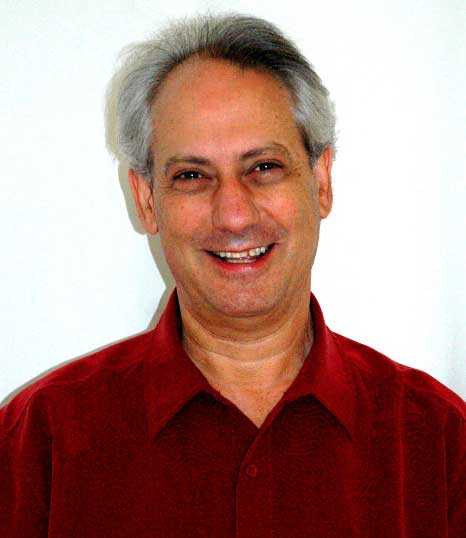
Jake Paul Fratkin, OMD, L.Ac. trained in Korean and Japanese acupuncture since 1975, and Chinese herbal medicine since 1982. He is the author of Essential Chinese Formulas (2014), and Chinese Herbal Patent Medicines, The Clinical Desk Reference (2001). Jake practices in Boulder, Colorado, where he specializes in internal disorders, infections, and pediatrics.
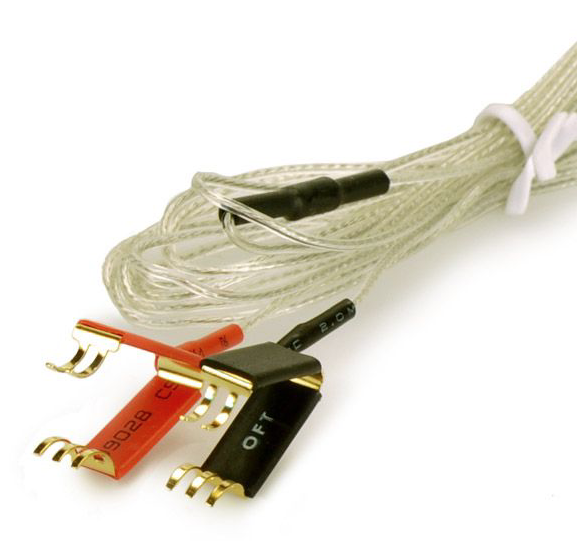
Brilliant
Thank you
fascinating thanks you very much